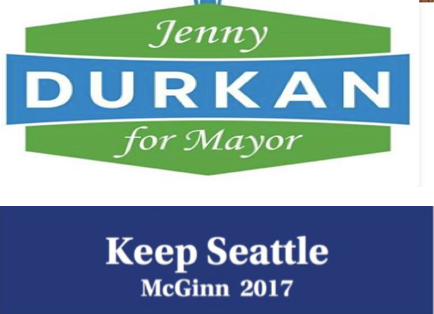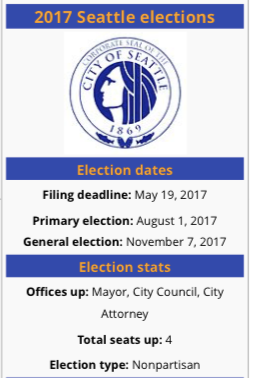Durkan and McGinn: Which One Will Pause MIZ?
Durkan also praised Murray’s housing policy: “Because of Mayor Murray’s leadership on HALA, our building boom will result in more affordable housing and millions of dollars for exploring affordable housing opportunities. As your mayor, I will promise you that we will use that money wisely and that we will be accountable for it.”
And McGinn in the Seattle Times.
That’s the line of attack McGinn, 57, hinted at in an interview. “We don’t need somebody who checks in with the dealmakers before they can run,” he said. “We have an affordability problem in part because the dealmakers are running this town.”
Durkan has praised Murray’s housing-affordability plan, which includes upzones paired with requirements for developers to help create low-income housing.
But McGinn has suggested he would start over, saying more neighborhood engagement is warranted.
These are top tier candidates. And we really need to watch them closely. Will Jenny Durkan meet with those of us who represent the small business owners who build and manage the vast majority of housing in the city? Will she do the math with us on MIZ? Will she support rent control and other unhelpful and tenant harming rules for people who manage rental properties? Will Durkan be persuaded that downtown developers represent the entire industry?
We’ll see.
And what if McGinn stops MIZ to play to angry neighbors? Does it really matter? Anything that stops that train is something we need to consider. While we don’t agree on much, neighbors and most developers do know that they were not included in the deal that led to MIZ have not been listened to since. Unfortunately, the displeasure in the neighborhoods about MIZ has been directed at builders of housing rather at the tiny group of insiders that created it in the first place.
In the end, Durkan and McGinn will evolve their positions on MIZ and other aspects of housing policy. The single most important question is will either of them, or any of the other candidates, recognize that the best thing we can do for sustainability and affordability is to build lots more housing of all types, in all parts of the city, for all levels of income. Adding more costs and hassles to producing housing will only make it more and more expensive.
Sticky Narratives: The Real Story of MIZ, and the Non-Profit Housing Industrial Complex
I was never a huge fan of the show X-Files although I did watch it and I am familiar with the two lead characters, FBI agents Fox Mulder and Dana Scully. Agent Mulder believes in aliens and other spooky things. Agent Scully is more of a skeptic. Many of the shows are about something unusual happening, the agents investigating it, and the kind of background debate about what the explanation might be. This is a familiar trope, perhaps one of the best examples is Scooby Do, where a group of kids and a goofy dog in a van manage to expose some supernatural event as really some kind of ploy to dupe people out of money or property. The notion of truth and what it really is as old as human beings: what’s really going on and what is behind what we’re experiencing in the world? I feel a lot like Fox Mulder these days, but slowly I think people are figuring what’s going on with affordable housing.
Two news outlets, one local and one national, have picked up on the idea that there is something wrong with the way we’re funding and building affordable housing. Locally, George Howland, who has worked for both The Stranger and the Seattle Weekly as well as a stint at City Hall wrote a very solid story about the problems with non-profit built housing at Outside City Hall. Howland sometimes gets attacked because Outside City Hall was created and is highly associated with John Fox, who I would call an opponent of growth. But Howland is working as a journalist with a point of view not unlike almost every other blogger and reporter on the civic beat.
Howland’s story is the first and only one other than my own writing here, to actually look at the numbers and ask questions about how expensive non-profit affordable housing has become to build and ask why. Not a single reporter has expressed even the slightest curiosity about why per unit costs are approaching $500,000 per unit. Like most things about housing in Seattle, after long explanations, eyes glaze over and interest drops. Most reporters and writers think the story is too complicated and too difficult to explain. The notion that production costs for non-profit housing are climbing, subsidies are running out, and that non-profit developers are now seeking money from the private sector sounds like, well, a conspiracy theory. Its much easier to write lines like, “HALA will exchange increases in density for inclusion or fees” and just leave it at that.
Laura Sullivan a reporter with National Public Radio called me early this year for a series she put together with Frontline about low income housing tax credits (LIHTC).
Sullivan told me in our several conversations that I was the only person that would criticize the program. I asked her more than once to resist the “greedy developer” narrative. I think it’s false and that the real issue isn’t that some for profit developer was able to leverage the creation of some affordable units into a profitable market rate project, but that the reason the program is producing less for more is that costs are out of control.
Sullivan was already very far along in her work on the story, and she already had much of it put together. But I am still hoping that they’ll take as hard of a look at how non-profits, at least on the west coast, are using the poetical process to extort money out of market rate builders of housing in the name of helping the poor instead of advocating for broad policy reform to lower the cost of producing all housing. This is why we’re pushing for an outside, bipartisan study of housing costs by the Joint Legislative Audit Review Committee (JLARC) to get to the bottom of costs and push to reduce them across the board. I think most of them are self imposed by regulation and that we could make things easier for real people looking for housing if we removed these restraints.
The truth is out there, folks. Our planet is under surveillance by powerful alien minds of uncertain motives. That, and local non-profits that have huge political leverage are running out of cash for their projects because they have limited rent revenue, too many rules, and are inefficient and now they’re coming after market rate builders to squeeze them for cash to build ever more costly units of housing that won’t meet the growing demand for housing. We’re on the knifes edge, if Mandatory Inclusionary Zoning (MIZ) is fully implemented we will see inexorable increases in housing costs as the market it forced to rationalize the costs of inclusion and fees, those costs will price up land and other costs in the region, subsidies will be consumed at an even greater rate, and this will require deeper inclusion and fee demands by non-profits.
Election Advice: Don’t Support Any Candidates Yet!
I sent this out as an email earlier this week. Events have changed things significantly since current Mayor Ed Murray has announced since I sent this he won’t be running for reelection. What’s likely to happen is more people will enter the race before filing ends on the 19th of May. I don’t think we should be in any hurry to support anyone for Mayor or Council yet.
Greetings,
Key dates ahead are the closing of filing which is end of the day, Friday, May 19th. Then the primary for all the candidates is August 1, 2017 and the general election November 7, 2017
Correction: Murray Did Not Bring ‘Developers and Housing Advocates to the Table.’
As the local press, the closest thing we have to historians of our city’s unfolding story, busily writes the obituary of Mayor Ed Murray, they are already embedding in that narrative basic falsehoods, what historian AJP Taylor in his important and controversial history of World War II, The Origins of the Second World War calls “legends,” things that people widely believe happened even though they didn’t. Today these legends would be called “fake news.” Here’s the latest from The Stranger embedded in their latest editorial that calls on the Mayor to not run for reelection because of allegations of child sexual abuse:
From taking up the cause of raising the minimum wage, to bringing developers and affordable housing advocates to the table, to your groundbreaking work on advancing LGBT equality during your tenure in the state legislature, you’ve made a positive mark on this city and this state. But your response to these allegations has eroded public trust in your leadership.
I’ve emphasized in bold italics the fake news. The Mayor, even in the most superficial sense did not bring developers and housing advocates to the table. I’d even challenge the formulation that those two categories of people, developers and housing advocates, are different. Residential housing developers, by definition, are housing advocates. They are at the permit counter all the time, trying to get permission from the City bureaucracy to do what they do best, build housing.
But more than that, the Mayor, whatever else he did do, brought people with different opinions and organizational affiliations, and professional perspectives to his Housing Affordability and Livability Agenda (HALA) Committee. There was some agreement there between those people. And later, a table was set but not for some wide swath of opposing ‘developers and housing advocates’ but for one developer, Vulcan, one non-profit housing developer, Plymouth Housing, a representative of the state’s largest non-profit housing developer advocate, the Housing Development Consortium (HDC), and the for profit attorney that represents the Washington State Housing Finance Commission. And at this small and exclusive table was born the Grand Bargain, the wide imposition of Mandatory Inclusionary Zoning (MIZ) upon all builders of housing even while those builders and developers were NOT consulted or included.
Look at the signers of the Grand Bargain.
That’s just the facts. Not a conspiracy theory. What Taylor says of historians applies, I think, to reporters of the news:
Historians often dislike what happened or wish that it had happened differently. There is nothing they can do about it. They have to state the truth as they see it without worrying whether this shocks or confirms existing prejudices.
The Stranger is not alone in these abuses of context and fact. It’s a simple wave of the hand and a shrug I’m sure that would follow from them or others in the press when confronted with this. But one simply must consider that those words “developers” and “housing advocates” mean something. How many of each of those were brought to “the table,” what was that table (HALA?), and what was the result? Housing advocates, as I suggest, are a diverse bunch from those who build housing for a living to those that think it should be no longer be a commodity. And developers? Same thing. Developers range from small scale builders to giant companies like Holland or Touchstone. What does The Stranger mean in this formulation, “bringing developers and affordable housing advocates to the table” and calling it part of the Mayor’s “positive mark on this city and this state?”
After digging around my memory of historical theorists I remembered another great historian, E. H. Carr who’s well known for his criticism of existing historical methodology. In his What is History?, I found this in a section in the opening chapter called “The Historian and His Facts,” and I think it’s relevant to today’s reporting on what’s going on with housing:
The necessity to establish these basic facts rests not on any quality in the facts themselves, but on an a priori decision of the historian. In spite of C. P. Scott’s motto, every journalist knows today that the most effective way to influence opinion is by the selection and arrangement of the appropriate facts. It used to be said that facts speak for themselves. This is, of course, untrue. The facts speak only when the historian calls on them: it is he who decides to which facts to give the floor, and in what order or context. It was, I think, one of Pirandello’s characters who said that a fact is like a sack – it won’t stand up till you’ve put something in it.
Let’s be sure we look carefully in the various sacks presented over the coming days, weeks, and months of this election season to be sure what they contain. In this case, the inspection would send the The Stranger back to their keyboards for a rewrite. Maybe something like, “The Mayor aspired to bring a wide array of people concerned about growth and housing to the table to achieve a lasting consensus about how to accommodate coming growth affordably in Seattle. That effort yielded benefits for some and criticism from many others. It remains to be seen whether his legacy will include this as a success in solving what some call Seattle’s housing crisis or a contributing factor to it getting worse.”
Mix Tapes: The More Things Change, the More They Stay the Same
I was listening to some really old recordings on my phone and I found one from a public meeting with Councilmember Mike O’Brien back on April 12th, 2011. That’s a long time, right. I mean back then we were still fighting against the tunnel, Mike McGinn was Mayor (his first go at the job), I was still on speaking terms with O’Brien, and most of the people that are now active in the land use issues surrounding zoning and land use weren’t around; and the ones that were are now occupied with other things. There are some exceptions to this, of course. But anyone paying attention back then and now will recognize the voice on this recording. I do. It’s mine. I didn’t include much from others that spoke out of respect. It was a public meeting, but it’s been so long I don’t know who the other voices are besides mine and Councilmember O’Brien. Here’s the clip of what I asked. The topic was the tunnel, and I changed the subject to land use.
Here’s a transcript if you can’t listen:
I wanted to ask you a land use question that ties back, I think, to this issue . . . You said you had a degree in economics, right? So, I’m a philosophy major so I really don’t understand economics, but one of the things I thought that was important about economics is the law of supply and demand. And so, when, I’m just playing Columbo here. So right now where we’re sitting is subject to, you’re going to be talking about rezones, the land use committee is going to be talking about rezones tomorrow, and one of the things that Council is pathologically talking about is housing affordability or affordable housing.
It seems to me that when you talk about affordability, you’re talking about price, and if you increase the demand for something, and decrease the supply for something you’re going to increase the price. So why does the Council continue to do things to reduce the supply of housing by limiting upzones, limiting the amount of development that can happen while whining about affordability; you know why aren’t you increasing the supply of housing by granting more upzones and letting the market kind of provide more housing supply, and if they oversupply the housing market, that’s great, that just means lower price. What am I missing?
So, right, so why is your incentive zoning policy sort of focused on trading, you know, making it harder to develop in exchange for creating a price point, why not just up the supply?
Someone jumps in right after this and asks, essentially, “Do you believe that?” To his credit, O’Brien said, “Yeah, I do. In part . . . when we have 75 percent of our land is zoned single-family.” The questioner goes on, and O’Brien starts to weasel and squirm, saying that he had been to Europe where cities are dense but buildings aren’t tall. Even then, one could see O’Brien’s tendency to wilt when faced with the brunt of bitter, angry, and entitled neighbors. He never stood a chance I guess. The topic changes again after this exchange.
I’m posting this mostly for the people who weren’t around back then and who might think I don’t know what I’m talking about or why. I’ve been at this a long time. And I think you’ll detect the same disdain for the City Council then that I have now; they simply aren’t functioning effectively nor are they really dealing with the issue we have: we need more housing!
Second, I also want to illustrate how little things have changed. The argument I was making could be one that I would make right this moment or tomorrow. At the time, the Council was about to consider upzones to Pioneer Square. They bungled this. I wrote a brutally long post about the upzones the day after this exchange praising, of all people, Councilmember Tim Burgess, who advocated for more density in Pioneer Square but lost the point at the final vote. The Council just couldn’t get its act together, even all the way back then. From that post (you’ll recognize another old timer as the first person who commented):
I was impressed with Councilmember Burgess today as he talked about making land use policy based on “what we want to happen” rather than fretting over “vague risks” that might or might not play out in the future. He characterized the psychology that often grips the Council with land use decisions. As he talked about staying on the low end of height proposed by the Department of Planning and Development (from a variable 100 feet to 120/150 feet depending on lot size) and the bigger heights suggested by the Downtown Seattle Association (180 feet) he quite astutely brought up the fact that preservationists casting doubt on the effect of the possible rezones on the historic designation of Pioneer Square could provide no certainty about their concerns.
Finally, things have really changed. Burgess, far from keeping this attitude has fallen into line with the real leader on the Council, Kshama Sawant. Today, Burgess is shuffling along toward retirement in a pantomime of progressive gestures mumbling about income taxes and socking it to landlords. That’s just bizarre. As I taunted some Jon Grant supporters the other day, even Tim Burgess and Sally Bagshaw are part of the “resistance” now. The degree to which the Council has been thoroughly cowed and humiliated by Sawant and her supporters is astonishing compared to their pro-tunnel stance back in 2011. Two years earlier, they airlifted the Governor Christine Gregoire to endorse Joe Mallahan (a person she’d never met before) because Mike McGinn opposed the tunnel. Back then, they were doing the bidding of the Downtown Seattle Association and the Greater Seattle Chamber of Commerce. Talk about blowing in the wind.
The question still rings, 6 years later: “Why not just up the supply?”
Image: Funky Stuff, From Wikipedia Commons by Antony Mayfield.







